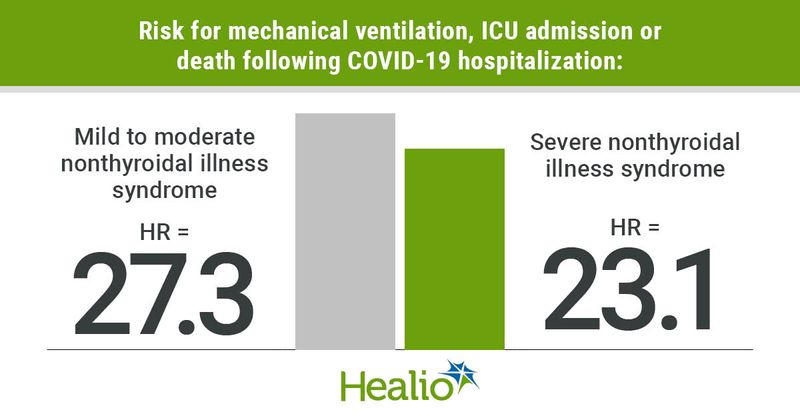Nonthyroidal illness syndrome associated with increased risk for severe COVID-19
Suppression of the hypothalamic-pituitary-thyroid axis is an indicator for disease severity among people hospitalized with COVID-19, according to study data published in BMC Endocrine Disorders.
“We found that several different types of thyroid dysfunctions were caused by COVID-19 illness, including mild to moderate nonthyroidal illness syndrome, severe nonthyroidal illness syndrome and subclinical hypothyroidism,” Juan Zheng, MD, PhD, of the department of endocrinology at Union Hospital, Tongji Medical College, Huazhong University of Science and Technology in Wuhan, China, and colleagues wrote. “The alterations of myocardial injury indicators, and coagulation function index were observed in all three different thyroid function groups. Besides, all three different types of thyroid dysfunction were associated with the severity of prognosis of COVID-19.”

Researchers conducted a retrospective study of 235 patients (median age, 61 years) hospitalized with COVID-19 at the west campus of Wuhan Union Hospital from Jan. 25 to March 17, 2020. Demographics and laboratory findings were collected from electronic medical records. Patients were placed into four groups according to thyroid function: normal (n = 184); subclinical hypothyroidism with free triiodothyronine between 2.63 pmol/L and 5.7 pmol/L, free thyroxine between 9 pmol/L and 19.18 pmol/L and thyroid-stimulating hormone greater than 4.94 IU/mL (n = 17); severe nonthyroidal illness syndrome with either a free T3 less than 2.63 pmol/L or free T4 of less than 9 pmol/L combined with TSH of less than 0.35 IU/mL (n = 11); and mild to moderate nonthyroidal illness syndrome with free T3 less than 2.63 pmol/L or free T4 less than 9 pmol/L and TSH between 0.35 IU/mL and 4.94 IU/mL (n = 23). The primary endpoint was the use of invasive mechanical ventilation, ICU admission or mortality.
Patients with either severe or mild to moderate nonthyroidal illness syndrome had high incidences of COVID-related complications, such as acute respiratory distress syndrome, acute cardiac injury, acute kidney injury, shock, hypoalbuminemia and coagulopathy compared with those with normal thyroid function or subclinical hypothyroidism. All adults in both nonthyroidal illness syndrome groups had severe COVID-19 compared with 75.5% of the normal thyroid function group and 76.5% of the subclinical hypothyroidism group (P = .005). Nonthyroidal illness syndrome was associated with a higher likelihood for antibiotic therapy, corticosteroid treatment and IV immunoglobin treatment during hospital admission.
Compared with the normal thyroid function group, people with mild to moderate nonthyroidal illness syndrome had the highest risk for mechanical ventilation, ICU admission or death (adjusted HR = 27.3; 95% CI, 7.07-105.7), followed by those with severe nonthyroidal illness syndrome (aHR = 23.1; 95% CI, 5.75-92.8). An increased risk for acute cardiac injury was observed in the severe nonthyroidal illness syndrome (aHR = 4.68; 95% CI, 1.76-12.4) and the mild to moderate nonthyroidal illness syndrome groups (aHR = 2.63; 95% CI, 1.09-6.36). Patients with low levels of free T3 also had an increased risk for acute cardiac injury compared with those with normal free T3 levels (aHR = 2.47; 95% CI, 1.13-5.37).
“The suppression of the hypothalamic-pituitary-thyroid axis could be a common complication in COVID-19 patients and an indicator of the severity of prognosis,” the researchers wrote. “Compared with normal thyroid function, patients with mild to moderate nonthyroidal illness syndrome and severe nonthyroidal illness syndrome had a worse prognosis and increased risk of myocardial injury. Our study suggests that mild to moderate nonthyroidal illness syndrome and severe nonthyroidal illness syndrome could be associated with the severity of prognosis of COVID-19.”

